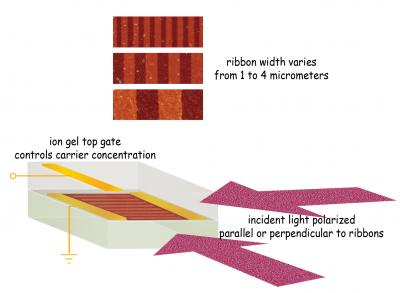Researchers at the University of California at Berkeley and the U.S. Department of Energy's Lawrence Berkeley National Laboratory (Berkeley Lab) have devised a tunable instrument based on graphene, which exhibits strong responsiveness to light at terahertz wavelengths.
Using the micro-scale device, the researchers have demonstrated that graphene’s responsiveness to light at terahertz wavelengths can be harnessed accurately. Research leader Feng Wang, who serves at Berkeley Lab's Materials Sciences Division as well as an assistant professor of physics at the University of California at Berkeley, stated that an array of graphene ribbons having a micro-scale width is a critical part of the equipment. The combined oscillations of the microribbons’ electrons can be used by altering the concentration of charge carriers in them and the width of the ribbons, he said.
 Tuning a Terahertz Metamaterial. Credit: Lawrence Berkeley National Laboratory
Tuning a Terahertz Metamaterial. Credit: Lawrence Berkeley National Laboratory
The combined oscillations of electrons are termed as plasmons. Wang stated that three-dimensional metal nanostructures demonstrate plasmons in high-frequency visible light. However, electrons in graphene shift in only two dimensions, as it has just a one atom thickness, he said. Plasmons form at relatively lower frequencies in two-dimensional systems, he added.
The researchers measured the terahertz light’s wavelength in hundreds of micrometers, while the width of the graphene ribbons utilized in the micro-scale device is merely1-4 µm. Wang said that a material whose structural dimensions are much smaller than the associated wavelength and whose optical properties are dissimilar with that of bulk material is called a metamaterial.
The micro-scale device is a predecessor of future instruments that can alter the intensity of terahertz light and harness the polarization and allow other electronic and optical components in all two-dimensional applications from astronomy to medical imaging.
Wang concluded that his research team has not only studied plasmon coupling and light at terahertz wavelengths in graphene but also developed a prototype for upcoming graphene-based metamaterials at the terahertz range.